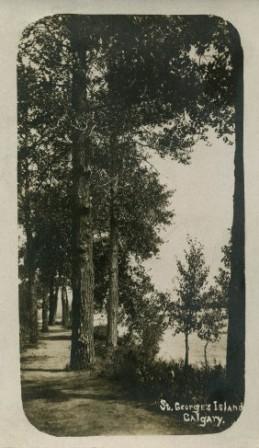Historic Calgary Postcards: St. George's Island
While Central/Memorial Park and Bowness Park were the showpieces of Calgary’s early parks, the Bow River Islands - St. George, St. Patrick and St. Andrew have an interesting history as parks. The Islands were first leased by town council for development of parks in 1887. The three islands were named for the patron saints of the United Kingdom - St. George of England, St. Patrick of Ireland and St. Andrew of Scotland.
In the late 19th century, there was no Prince’s Island. It was merely a shifting gravel bar and more of an isthmus. That’s until Peter Prince created a channel in the river (now the lagoon) to allow logs to float to Eau Claire Lumber Mill at the site of the current Eau Claire Market. The St. Andrew Island was created by a lagoon between it and St. Patrick Island which has since been filled in to create one island.
Back in1892 through to 1900, a ferry service connected St. George's Island to town, increasing its popularity as a weekend playground. In 1900, a foot bridge was constructed. Construction of the existing St. George’s Island Bridge for cars and pedestrians ridge in 1908 cost of $25,000. At the same time an old Elbow River Bridge was moved to the island’s north side providing a link to the then new Calgary General Hospital and the new communities of Bridgeland and Riverside. In 1910, the federal government gave the islands to the town, on the condition they remain parks.
It was the natural beauty St. George's Island that captured the attention of Calgarians and Park Superintendents. The Island was enhanced with the planting of more trees, cinder pathways, fireplaces for picnickers and the Biergarten dance hall band shell. By 1911, the island was home to over 200 weekend picnic parties and the Sunday afternoon band concerts drew an average of 1,500 to 2,000 people (note the population of Calgary was only 43,704).
The two-story German Biergarten, built on the site of today’s Calgary Zoo’s Conservatory at a cost of $4,560 in 1912 became a well-known Calgary architectural landmark. Much to the embarrassment of Parks Superintendent Richard Iverson and the City, it was illegal to sell beer on City property so the building was converted to a teahouse. However, this didn’t work well either as the noise from the bands on the top floor drove the tea drinkers from the main floor. It became known as the “old bandstand.”
Several attempts were made to create a zoo in Calgary early in the 20th century. The zoo at St. George’s Island began in 1917 when two wayward deer found in the park and were corralled in cages by the dogcatcher near the Biergarten. The deer were so popular, the zoo began to grow under the direction of parks superintendent William Reader. By 1929, the Calgary Zoological Society was formed which was the beginning of St. George's Island as the home of the Calgary Zoo Botanical Garden & Prehistoric Park.
This postcard reminds me of George Seurat's 1984 painting a Paris Park titled "A Sunday at La Grande Jatte (see below). Calgary's sense of place was more closely linked to European at the turn of the 20th century than it is today.
Calgary was once called "Paris on the prairies."
A Sunday at La Grande Jatte, George Seurat, 1884
The explosive growth of Calgary, in the early 20th century prompted a need to put some serious thought into long-term city planning. In 1912, British Landscape Architect Thomas Mawson was commissioned by the city to prepare a master plan to address the rapid growth of the city. Mawson's proposal was an ambitious plan on par with Haussmann's rebuilding of Paris during the reign of Napoleon III. The focus of Mawson's plan was on the Bow River, not the CPR railway line.
The biergarten, dance hall and eventually tea house on St. George's Island.
St. George Island summer amusement park.
Prince's Island early 20th century.
Eau Claire Lumber Mill at Prince's Island
A landscape designer by profession, Reader emigrated to Canada from England in 1908 when he was 33. He became parks superintendent in 1913. He was responsible for the planning and implementation of establishing Calgary's first parks - Central/Memorial Park, Riley Park, Mewata Park, St. George Island and the Memorial Drive trees to commemorate soldiers killed in World War I. During his 29 year rein as parks superintendent he transformed Calgary from a dusty prairie town to "the garden city of Western Canada."
If you like this blog, you might like:
Historic Downtown Calgary Postcards



